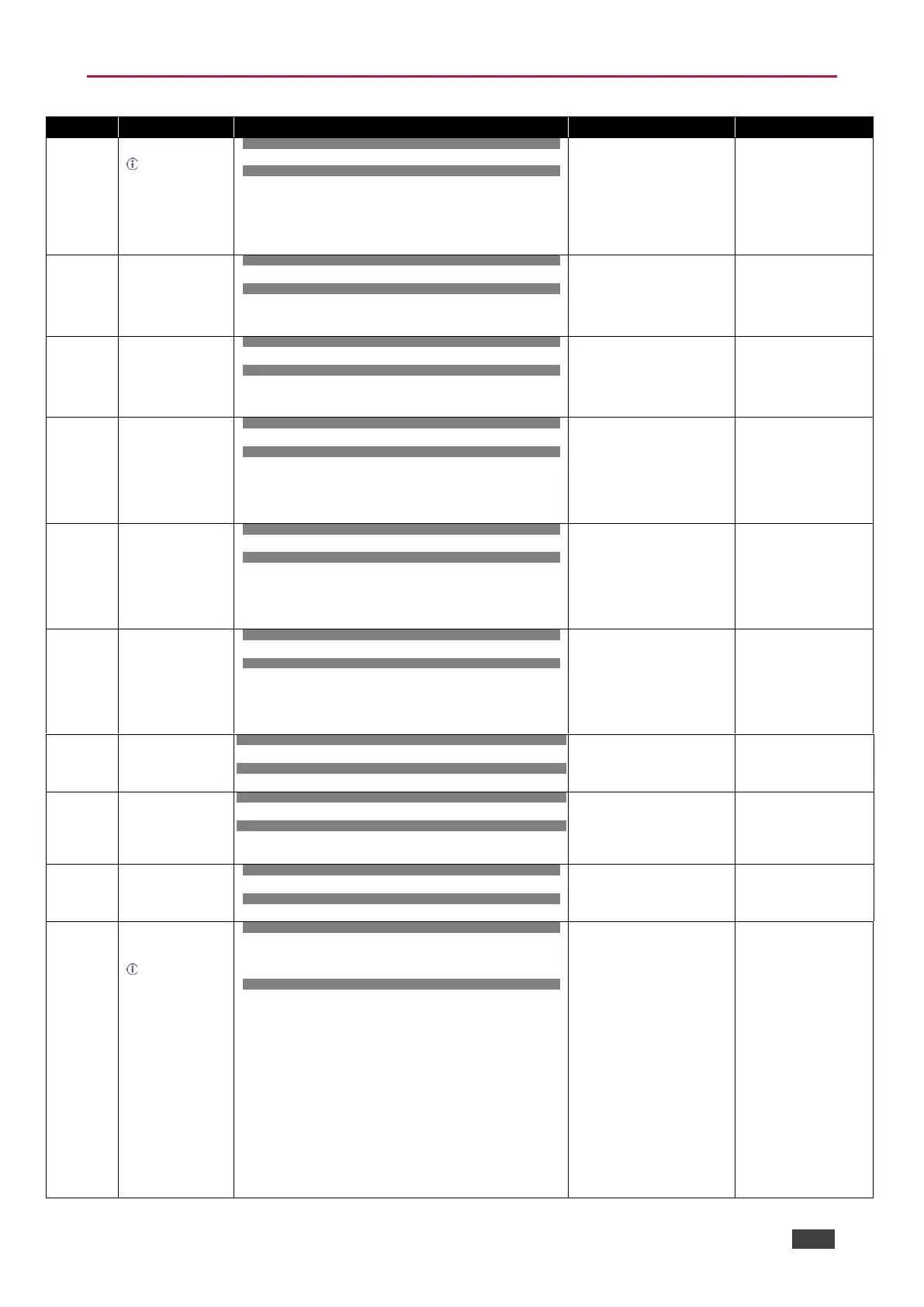Protocol handshaking.
Validates the
Protocol 3000
connection and gets the
machine number.
Step-in master products
use this command to
identify the availability
of a device.
COMMAND
#<CR>
FEEDBACK
~nn@ok<CR><LF>
COMMAND
#AUD-LVLio_mode,io_index,vol_level<CR>
FEEDBACK
~nn@AUD-LVLio_mode,io_index,vol_level<CR><LF>
io_mode –
1 – Output
io_index – 0
vol_level – Volume level 0 to
100;
++ (increase current value by 1);
-- (decrease current value by 1)
Set audio output level to 50:
#AUD-LVL1,0,50<CR>
COMMAND
#AUD-LVL?io_mode,io_index<CR>
FEEDBACK
~nn@AUD-LVLio_mode,io_index,vol_level<CR><LF>
io_mode –
1 – Output
io_index – 0
vol_level – Volume level 0 to
100;
++ (increase current value by 1);
-- (decrease current value by 1)
Get audio output level
#AUD-LVL?1,0<CR>
Set input auto switch
mode (per output).
COMMAND
#AV-SW-MODElayer_type,out_index,connection_mode<CR>
FEEDBACK
~nn@AV-SW-MODElayer_type,out_index,connection_mode<CR><
LF>
layer_type – Number that
indicates the signal type:
1 – Audio+Video
out_index – 1
connection_mode – Connection
mode
0 – manual
1 – priority switch
2 – last connected switch
Set input auto switch mode
to manual:
#AV-SW-MODE1,1,0<CR>
Get input auto switch
mode (per output).
COMMAND
#AV-SW-MODE?layer_type,out_index<CR>
FEEDBACK
~nn@AV-SW-MODElayer_type,out_index,connection_mode<CR><
LF>
layer_type – Number that
indicates the signal type:
1 – Audio+Video
out_index – 1
connection_mode – Connection
mode
0 – manual
1 – priority switch
2 – last connected switch
Get the input audio switch
mode:
#AV-SW-MODE?1,1<CR>
COMMAND
#BUILD-DATE?<CR>
FEEDBACK
~nn@BUILD-DATEdate,time<CR><LF>
date – Format: YYYY/MM/DD
where
YYYY = Year
MM = Month
DD = Day
time – Format: hh:mm:ss where
hh = hours
mm = minutes
ss = seconds
Get the device build date:
#BUILD-DATE?<CR>
COMMAND
#CECstate<CR>
FEEDBACK
~nn@CECstate<CR><LF>
Set display to OFF via CEC:
#CEC OFF<CR>
COMMAND
#CEC-PASSstate<CR>
FEEDBACK
~nn@CEC-PASSstate<CR><LF>
state – CEC state
0 – Off
1 – On
Set bypass device state:
#CEC-PASS1<CR>
Get CEC device bypass
state.
COMMAND
#CEC-PASS?<CR>
FEEDBACK
~nn@CEC-PASSstate<CR><LF>
state – CEC state
0 – Off
1 – On
Get bypass device state:
#CEC-PASS?<CR>
Copy EDID data from
the output to the input
EEPROM.
Destination bitmap
size depends on device
properties (for 64 inputs
it is a 64-bit word).
Example: bitmap
0x0013 means inputs
1,2 and 5 are loaded
with the new EDID.
In certain products
Safe_mode is an
optional parameter.
See the HELP
command for its
availability.
COMMAND
#CPEDIDedid_io,src_id,edid_io,dest_bitmap<CR>
or
#CPEDIDedid_io,src_id,edid_io,dest_bitmap,safe_mode<CR>
FEEDBACK
~nn@CPEDIDedid_io,src_id,edid_io,dest_bitmap<CR><LF>
~nn@CPEDIDedid_io,src_id,edid_io,dest_bitmap,safe_mode<
CR><LF>
edid_io – EDID source type
(usually output)
1 – Output
src_id – Number of chosen
source stage
1 – HDMI
edid_io – EDID destination type
(usually input)
0 – Input
dest_bitmap – Bitmap
representing destination IDs.
0x01 – HDBT
0x02 – HDMI
0 – indicates that EDID data is not
copied to this destination.
1 – indicates that EDID data is
copied to this destination.
safe_mode – Safe mode
0 – device accepts the EDID as is
without trying to adjust
1 – device tries to adjust the EDID
(default value if no parameter
is sent)
Copy the EDID data from the
Output (EDID source) to the
HDBT input:
#CPEDID1,1,0,0x01<CR
>

